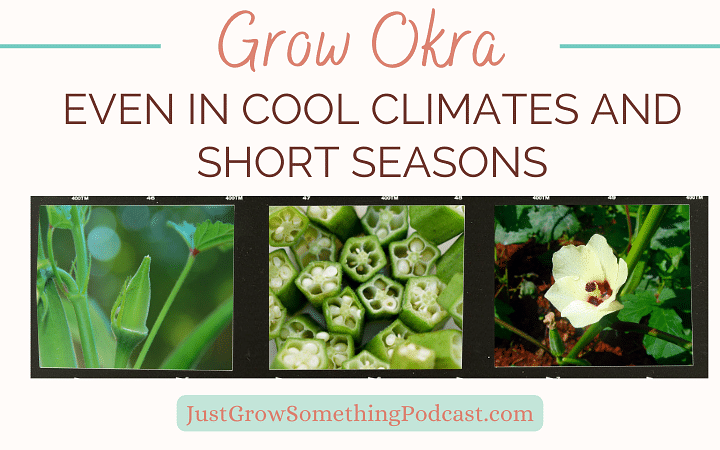
Okra is a heat-loving plant that likes hot weather, full sun, and well-drained soil. But even northern gardeners can manage a crop of okra with just a few tricks. In this article we'll cover standard growing practices for okra and then cover some for short-season or cool-climate areas.
 Okra is very sensitive to cold temperatures, so even though you see instructions to plant it after the last frost or even four weeks after last frost, don’t let that be your guide. You want your soil temperature at 75F, and overnight lows staying above 60F. Most okra varieties need a minimum of 55 to 65 frost-free days with daytime temperatures consistently above 85°F (29°C) to meet its full potential; some heirloom varieties take up to 75 days to produce. If you are in zone 7 or further south in the northern hemisphere this shouldn’t be any kind of problem for you. It’s the rest of us in zone 6 and further north that need to consider our varieties and timing a bit more.
Okra is very sensitive to cold temperatures, so even though you see instructions to plant it after the last frost or even four weeks after last frost, don’t let that be your guide. You want your soil temperature at 75F, and overnight lows staying above 60F. Most okra varieties need a minimum of 55 to 65 frost-free days with daytime temperatures consistently above 85°F (29°C) to meet its full potential; some heirloom varieties take up to 75 days to produce. If you are in zone 7 or further south in the northern hemisphere this shouldn’t be any kind of problem for you. It’s the rest of us in zone 6 and further north that need to consider our varieties and timing a bit more.
Unless you are in a short-season area, direct sowing your okra is the best path. The seeds should be planted a half inch deep and about 10 to 18 inches apart or thinned to that distance apart for best results.
If you are in an ideal climate for growing okra, they can get up to 10 feet tall, so be sure you keep this in mind when planning where these will be growing in your garden. There are dwarf varieties of okra if you need something more compact so that it doesn’t shade out other plants being grown in a small area.
With most crops the more fertile the soil the better but, in my experience, okra can scavenge nutrients pretty well and has grown in some not-so-great soils on my place. Amend with compost at the beginning of the season and if your soil is particularly void of nutrients then use a continuous release plant food of some type or side-dress with a balanced fertilizer. You don’t want high nitrogen unless you’re really depleted because then you’ll end up with lots of vegetation and very few flowers.
I’ve also noticed our okra tends to do just fine in a drought. I’ve never seen a substantial drop in yield when we’ve had long periods without rain, and I’ve never irrigated mine. So, if you have a challenging area in your garden this might be a good spot for okra.
Another cool thing about okra is it doesn’t need as an acidic soil as most of our garden plants. It does best in soil with a pH between 6.5 and 7.0, so pretty neutral, but can do fine in a pH as high as 7.6. This is about the same as what we aim for in growing asparagus. So, if you have an area near an amended asparagus bed you can plant okra there and know that the soil pH will be conducive for both crops. And since okra deters whiteflies, it can be a good companion crop for the asparagus. And that deterring property may just be a reason to grow okra in the garden or on the perimeter of the garden even if you don’t like it. Okra also gets along well with peppers, cucumbers, basil, eggplant and melons.
There’s not much to do with the okra once it sprouts other than keeping the weeds down. It really is very hands off.
If you are trying to grow okra in a short-season or other difficult area, here are some tricks to getting them to a harvest before your first frost.
- Choose fast-maturing varieties. There are some okra plants that are bred to mature in as little as 50 days. Blondy, Alabama Red and Jambalaya are a few.
- If you have enough frost-free days but you live in an area where the summers can just be cooler overall, like some areas of the Pacific Northwest or mountainous regions like Colorado, you can also look for varieties that are specifically for cooler weather, these include Annie Oakley II, Jing Orange and Blondy.
- Start your seeds indoors. I know I said okra does best when it’s not transplanted but if you only have a short window of opportunity, you gotta' do what you gotta' do. Start them indoors, preferably in something like a peat pot, soil block, paper pot or something else that won’t require you taking the plant out of the container before putting it into the ground. If you can just pull open the bottom of the pot and drop the plant into the soil pot and all without disturbing the tap root, the plant will be better for it.
- To speed up the germination you can also soak the seeds in water overnight to get them sprouting more quickly. You want to get your okra started indoors about a month before you plan to transplant them.
And, yes, you can grow okra in containers. You’ll want to go for the dwarf varieties that don’t get as big because the shorter plants also tend to be more narrow, both traits that lend themselves to container growing. And okra is self-pollinating, so you don’t need a ton of plants in order to ensure cross-pollination. Which means if you are a short-season gardener who is desperate for okra, you can go ahead and start some larger pots of okra indoors and simply move the outside once the temperatures are conducive. Then if an early frost threatens, you’ll be able to move the containers indoors to protect your plants and finish out the growing season.
Okra can be a very productive crop in almost any climate. It's all a matter of knowing a few tricks to get them to harvest before your first frost. Happy planting!
Your Friend in the Garden,

Resource episodes:
